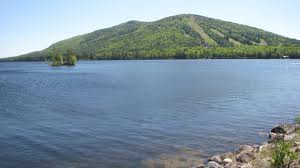Maine Lakefront Property Owners Check For Aquatic Invaders

Maine Jewish Summer Camp Exhibit in Portland, Maine
June 15, 2012
Out and About for the Mid Coast Lakes Region of Maine June 21-27
June 21, 2012Maine Lakefront Property Owners Check For Aquatic Invaders

Shawnee Peak Ski Area and Pleasant Mountain overlooking Moose Pond in Bridgton, Maine
As Maine lakefront property owners, we know that fast-growing invasive aquatic plants are a threat to water quality and can ruin our enjoyment of our lakes.
A native plant is one that originated here in Maine. “The growth of these plants is ‘held in check’ by the various organisms in the ecosystem,” says Laura Wilson, scientist for the UMaine Cooperative Extension. “They have competitors for space, light and overall survival.”
Invasive plants, on the other hand, are not from Maine and have no competitors to “keep them in check.” They simply grow out of control. It only takes a fragment or tiny seed for them to take hold. Serious infestations can allow the plants to grow as thick as a blanket on the surface of the water, blocking the exchange of gasses, thus causing fish kills and disrupting other wildlife.
Folks, trained by the Maine Volunteer Lake Monitoring Program to participate in Invasive Plant Patrols, survey many of our lakes to screen for these aquatic invaders. Found in Maine so far are variable leaf water-milfoil (and a hybrid form of this plant), Eurasian water-milfoil, curly-leaf pondweed and hydrilla. In some other New England states and Quebec the following have also appeared: Water Chestnut, European Frog Bit, Yellow Floating Heart, Fanwort, Parrot Feather, European Naiad and Brazilian Elodea. Their names, such as Yellow Floating Heart and Parrot Feather, sound innocuous, but they have outsized impacts.
Once a lake or pond is infested, the plants can’t be eliminated, but can be controlled with a permit from the Maine DEP. Hand removal by divers works for small infestations, but Suction Harvesters, benthic barriers over the top of the plants and draw downs to expose the plants to Maine’s freezing temperatures are the control methods most frequently used. Herbicide applications is the last ditch effort–in Maine this is used on a very limited basis. Unfortunately, there is no perfect solution and not everyone agrees about what to do.
The discovery of aggressive invasive plant species underscores the need for boat owners to clean their boats and take other steps to avoid accidentally spreading them and non-native species that can threaten our Maine waterways.
Before you head out onto the lake, please check your boat, trailer and other equipment. Do the same when you return. There is a fine for carrying any plant fragments with you–invasive or not.
Courtesy Boat Inspectors are stationed at many boat launches. If you have any questions, they’ll be happy to help you. Should you site what you think is an invasive, note the location and contact your lake association, the Lakes Environmental Association or the MVLMP.
To learn more about lakefront property listings on Moose Pond in the Sebago Lakes Region, just click on the green box above.
Click on the links below to read blogs about how lake associations are preventing or combating invasive aquatic plants:
Northeast, Milton and Townhouse Ponds form Milton Three Ponds Chain in Lebanon, Maine
Saving Sebago Cove from the Green Monster
